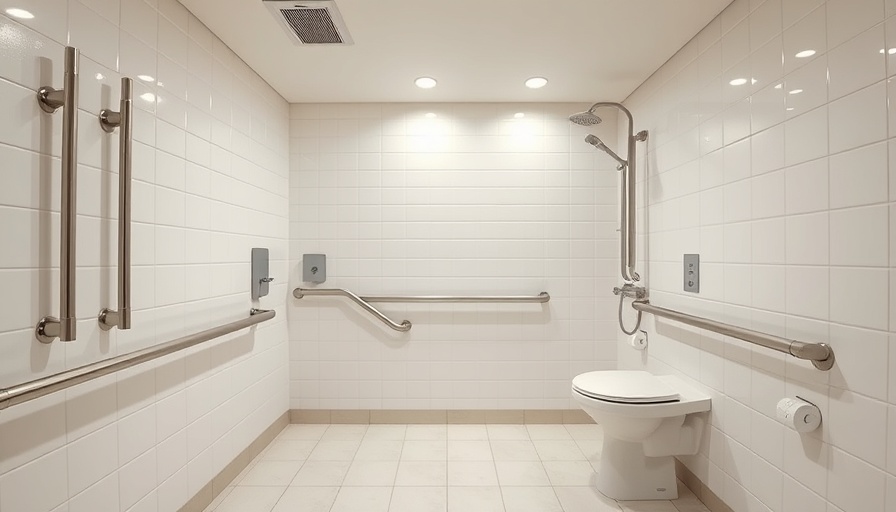
Transforming Spaces: The Importance of ADA-Compliant Bathroom Renovations
In Toms River, the dialogue around bathroom renovations often dances around aesthetics and functionality. However, when considering an upgrade, adherence to ADA (Americans with Disabilities Act) compliance should also be at the forefront. This isn’t just about meeting regulations; it’s about enhancing the experience and quality of life for all users, especially those with disabilities. A well-designed ADA-compliant bathroom can open doors to inclusivity, provide safety, and can even enhance the value of your home.
Understanding ADA Compliance: What You Need to Know
Before diving into renovations, it’s vital to understand what ADA compliance entails. The ADA sets forth guidelines that dictate design criteria for accessibility. For example, doorways need to be a minimum of 32 inches wide to allow for wheelchair access, while sinks should not exceed 34 inches in height. Beyond these measurements, ADA compliance encourages the use of contrasting colors and textures, as well as features that aid those with visual impairments. So, while you’re choosing new ceramic tiles, think about their texture and color contrast to ensure safety and usability.
Key Features of an ADA-Compliant Bathroom
When undertaking a bathroom renovation, certain features stand out as vital for ADA compliance.
Grab Bars: These are essential for stability and safety, particularly in showers and near toilets. Ensure they are installed correctly, around 33 to 36 inches from the floor, and consider using stylish finishes that blend seamlessly into your bathroom design.
Vanities and Sinks: Choose wall-mounted sinks for easy wheelchair access, ensuring the counter height does not exceed 34 inches. Opt for lever-style faucet handles for ease of use, which are practical for those with limited mobility.
Toilet Design: A comfort-height toilet, set between 17 to 19 inches, provides more user-friendly access. Space is a crucial consideration, too – ensure at least 60 inches of clearance around the toilet for ease of movement.
Enhancing Usability: Beyond Compliance
While meeting ADA regulations is a must, making thoughtful design choices can elevate the entire bathroom experience. Think about incorporating non-slip flooring throughout your bathroom. Safety features like these not only fulfill compliance but contribute to a more welcoming atmosphere for everyone.
Moreover, integrating smart technologies, like automatic faucets and motion-sensor lighting, can make life easier for those with disabilities. These upgrades can increase comfort while fulfilling accessibility needs.
A Case Study: Real-Life Success Stories
Consider the transformation of a local Toms River family’s home, where they converted a standard bathroom into a beautifully ADA-compliant space. By utilizing natural lighting and choosing contrasting colors, they created an inviting atmosphere. Not only did they meet compliance standards, but they also significantly increased their home’s value and usability for elderly family members. Such successful renovations highlight the multifaceted benefits of investing in ADA-compliant upgrades.
Future Trends in Bathroom Renovations
As technology advances, so does the world of home renovations. The future may see an increase in *universal design* practices, which will go hand-in-hand with ADA compliance. This approach involves creating spaces that are usable by all people, regardless of age or ability, leading to designs that are not only functional for individuals with disabilities but are also aesthetically pleasing for everyone.
Homeowners today are increasingly recognizing that inclusivity in design isn't just a legal obligation but also a moral one, reflecting a shift in societal attitudes towards accessibility. The increasing demand for sustainable materials also means an opportunity to combine eco-friendly practices with ADA-compliant designs, making renovations both responsible and stylish.
How to Go About Your Bathroom Renovation
When embarking on a bathroom renovation journey, it’s best to consult with both designers and contractors experienced in ADA compliance. A professional can guide you in understanding the specific needs of your space. You might consider having a certified access specialist assist in designing a layout that meets ADA standards while keeping your personal tastes in mind.
After all, creating a functional and beautiful bathroom doesn't have to come at the expense of comfort and accessibility. With careful planning and consideration, you can achieve a space that everyone can enjoy.
Remember, upgrading your bathroom to be ADA-compliant is more than a financial investment; it’s an investment in the quality of life for you and your loved ones.
 Add Row
Add Row  Add
Add 




 Add Row
Add Row  Add
Add 

Write A Comment